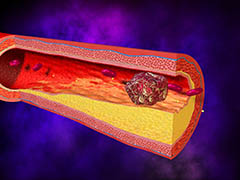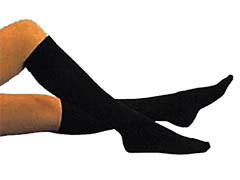Sorry about that link saved.  Here's an article on Deep Vein Thrombosis with some information
Here's an article on Deep Vein Thrombosis with some information...
Quote:

- Deep vein thrombosis (DVT) is most known as being caused by sitting in a confined space for long periods of time leading to blood clot formation
- Symptoms: tender/swollen legs, muscle pain
- Blood clot prevention: taking natural blood thinners like nattokinase, cod liver oil, vitamin E, garlic
- Warning signs you�re at risk: family history, suffered trauma to legs, heart disease, liver diseases, diabetes, obesity and 40-year-old or older
Deep vein thrombosis (a.k.a DVT) is a well known condition, largely thanks to publicity and news related to passengers on aircraft developing the condition. DVT can be caused by sitting in a confined space for protracted periods of time.
Aircraft seating is a good example of the kind of confined space that might cause DVT, but there are measures you can take to prevent the condition developing, and warning signs that you can identify if you are at risk.
DVT can affect people who are otherwise healthy and fit. In fact, if you are very fit, the risk of DVT may be higher as a low resting pulse may provide the ideal conditions for DVT to develop during a lengthy period of inactivity. Those who have a family history of DVT may also face an increased risk, or those who have previously had DVT themselves. People who have suffered trauma to their legs, or who have had surgery in the feet, legs, pelvic or abdominal area face an increased risk, as do those with
heart disease, liver disease, certain cancers or diabetes. You are also more likely to develop DVT if you are obese or over 40 years of age.
First of all, if you are on an aircraft, practice deep vein thrombosis prevention (or deep vein thrombosis prophylaxis). Avoid becoming dehydrated by drinking plenty of water and make sure you move around regularly. Compression socks may also help.
Deep vein thrombosis symptoms include: tenderness or swelling in the legs, muscle pain, and some discoloration in a painful area. Symptoms of deep vein thrombosis may not occur until many hours after you have disembarked the aircraft. Shorter flights, for example those of a couple of hours, should not be long enough to cause DVT.
If you are planning a long flight, here are some precautions and natural preventative measures you can take:
Nattokinase: nattokinase is an enzyme that comes from a Japanese food known as natto. It is made from soybeans. Research has shown that nattokinase helps to prevent and actually dissolves
blood clots. It may also help to prevent hardened arteries, stroke, heart attack, senility and angina. Although nattokinase is a natural remedy, you should consult your doctor before taking it if you are already taking
blood thinning drugs or if you have a bleeding disorder.
Other naturally preventative remedies include cod liver oil and
vitamin E, which may help to prevent blood clotting (including clots caused by DVT). Horse chestnut has been shown to work for people with circulatory problems such as
varicose veins. Gingko and butcher�s boom are also thought to help with circulation.

Garlic may also reduce blood clotting and is a naturally effective blood thinner.
Research has also shown that two substances present in lemon juice, namely lemon polyphenol and citric acid, may help to prevent DVT developing by
improving blood circulation. Therefore, if you are on a long flight, ask the flight attendant for some lemonade, or a large slice of lemon in your drink.
https://www.nutralegacy.com/blog/gene...ral-treatment/